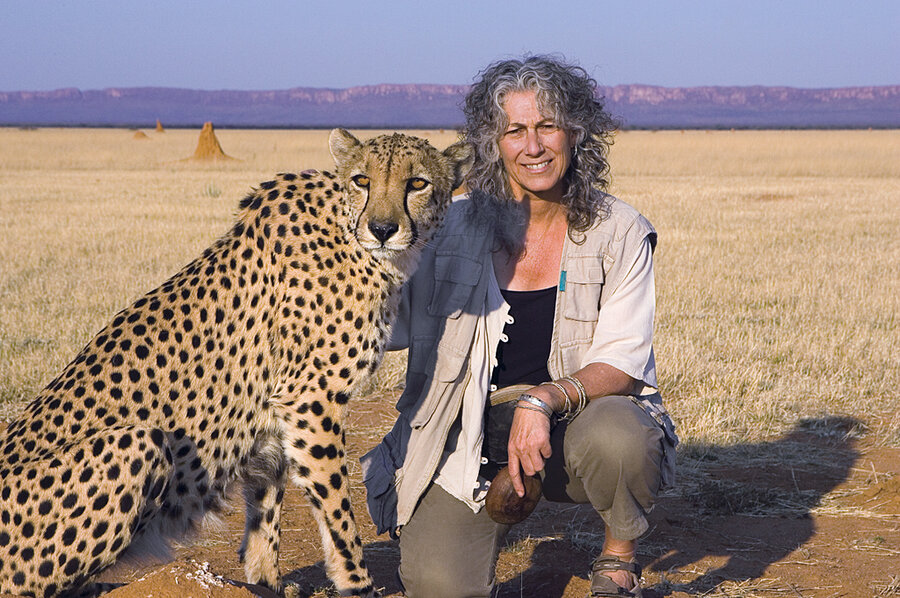Using a wood chipper to save cheetahs, Africa's most endangered big cats
Loading...
| Indianapolis
It takes an unusual mind to bring a wood chipper to the desert. But in her 37-year quest to help save Africa's most endangered big cat – the cheetah – Laurie Marker has gotten used to taking unusual steps.
"Actually, I have two," she says of the chippers in an interview in Indianapolis, where Dr. Marker, founder of the Cheetah Conservation Fund (CCF), was being honored last fall as a finalist for the Indianapolis Prize, the largest prize given in the world for animal conservation.
The wood chippers are part of her conservation campaign – notable for its down-to-earth practicality and emphasis on innovative solutions that will be good for both local people and the cheetah.
Cheetahs, which move at speeds of up to 70 miles per hour, were being blinded by running through thick, prickly thorn bush undergrowth that is eating up Namibia's land, causing problems for farmers as well as big cats. Unable to hunt wild game, the injured animals were preying on livestock, causing farmers to trap them.
Marker's solution: Send in the wood chippers.
The chipped thorn bush now is turned into ecoblocks, which are sold as fuel in South Africa and Europe. Studies show that both cheetahs and leopards are returning to the cleared areas. Marker is also contemplating turning thorn bush chips into biomass, which could be used to generate electricity. More than half of Namibia's citizens still lack electrical service.
"The highway is littered with noble causes out there that haven't been effective," says Gregg Hudson, executive director of the Dallas Zoo and the Children's Aquarium at Fair Park in Dallas, who served on CCF's board from 2001 to 2006. "Laurie – this is one of the reasons I've really enjoyed working with her – sees all sides of a problem.
"The cheetah – that's her passion. But she's not coming down in that traditional role: 'You need to save them because it's the right thing to do.' She's immersed herself in the culture … and gone about trying to find solutions that are win-win for everybody. That, to me, is so refreshing."
Another example of this win-win approach is CCF's guard-dog program. Marker sat down with farmers and discovered they were using small herding dogs instead of guard dogs and thus losing valuable livestock to cheetah attacks. CCF set up a program to give farmers large Turkish Kangal dogs, which bond with the herd and scare off the cheetahs.
The result: an 80 percent dip in livestock losses, a long waiting list for Kangal dogs, and fewer cheetahs killed by farmers.
IN PICTURES: Endangered animals
"Laurie has one of the best connections between her left brain and her right brain of anyone I've ever come across," says Michael Crowther, chief executive officer of the Indianapolis Zoo, which administers the prize. He calls her a "brilliant scientist" who has helped discover the genetic makeup of cheetahs.
But there's another side to Marker that's intensely practical. "A lot of it revolves around trying to see problems from a variety of angles," she says. "I don't think there are problems; there are unknowns."
While living in Oregon in the 1970s, Marker worked at a wildlife refuge and raised a tiger and a cheetah from infancy. They slept with her in her mom's guest bedroom in northern California when Marker took them on educational tours of area schools. (She and Khayam, the cheetah, appeared on "The Tonight Show" with Johnny Carson.)
Marker had no plans to leave the West Coast for a life in the African desert.
"I kept thinking that someone would go and take care of the wild cheetahs if I told enough people to do it," she says. "I mean, I had a job. I had a life. I call it the 'they factor': 'They will take care of it.' " Eventually, she says she realized," 'They' is me."
Marker traveled to Namibia in the 1980s, but refused to live in a country that was still under apartheid. When Namibia declared independence in 1991 and ended apartheid, she bought her plane ticket.
Both CCF and Namibia turned 20 last year. Along with its work in Namibia, CCF has helped establish cheetah conservation programs in Algeria, Botswana, and Iran.
When people talk about making changes "little by little," Marker disagrees. "No. Fast and big," she urges.
Because cheetahs are genetically quite similar to each other, they are more vulnerable to threats from climate change to human encroachment. "Being limited in their gene pool – they do become much more vulnerable," Marker says.
But despite some daunting challenges, success is possible. "I know it's attainable," she says. "The only thing that we're lacking is money and speed. But we know what we need to do."
Successes do happen. Last year, Marker found that cheetahs had returned to neighboring Angola after decades of absence.
"It was a big 'wow,' " she says.
Her approach to conservation is a practical one. It boils down to "listening and thinking – and thinking creatively and outside of the box," she says.
"You have to be very patient. If you lose your patience, you have to go back to ground zero. So, don't lose your patience because you don't have time to go back."
For more stories about people making a difference, go here.


